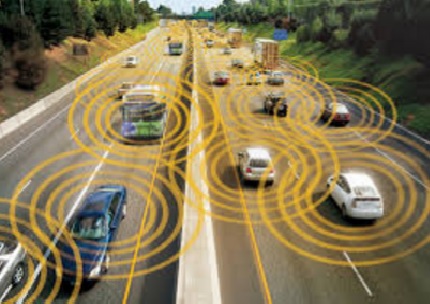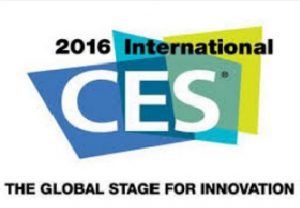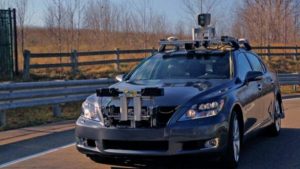Connected cars, aka connectivity, is thought to have been the very first of the next-generation technologies serving as game changers for the auto industry, personal mobility, and ground transportation. The ideal will be to someday have automated, electric vehicles tied together through a Vehicle-to-Vehicle (V2V) communication network — and  connected to everything else through the next version, Vehicle-to-Everything (V2X). The hope is that traffic could be controlled, collisions avoided, and energy use made more efficient.
connected to everything else through the next version, Vehicle-to-Everything (V2X). The hope is that traffic could be controlled, collisions avoided, and energy use made more efficient.
And it will be connected to everything else, such as your home. It’s becoming quite common to see intelligent mobile devices able to manage what’s going on in your house — security system, heating, lighting, recording a sporting event, etc. Why not tie you car into all of it for electric vehicle charging, checking diagnostics, energy consumption, and getting it ready to take you to work in the morning?
Connectivity goes back to General Motors and Motorola introducing OnStar in 1996, eventually offering subscribers security, emergency services, hands-free calling, navigation, and remote diagnostics. Once smart phones started showing up in the late 2000s, connectivity began tying phones to a car’s dashboard control panel for these types of convenience features; plus what became known as “infotainment” that could include hearing your favorite music artist or the Howard Stern show on SiriusXM Radio. It eventually shifted over to voice commands to keep eyes on the road and the process more automated and easy to use.
These days, three tech developments tend to come up when connected cars are being discussed — 5G, V2V/V2X, and IoT.
For 5G, debate continues over which region will win the race to bring the leading-edge technology and clear the hurdles for adoption — North America, Europe, or Asia? Having a mobile device with 5G means higher capacity and increased bandwidth compared to 4G. It has the potential to clean up the problems on 4G as everything you can think of switches over to intensive, sophisticated software and data transfer needing a lot more bandwidth.
But the revolution will take much longer than planned. Last year, AT&T and Verizon went live with their 5G networks in a small, targeted set of cities. T-Mobile promised to clear its acquisition of Sprint and integrate their networks into the largest 5G network out there. The legal hurdle was cleared on April 1, but its presence in 5G is at the beginning phase. Handset makers have been rolling out a number of new models compatible to the new standard. However mobile device users aren’t seeing any real improvements yet in the existing cellular networks out there from AT&T, Verizon, and Sprint/T-Mobile.
But the technology does have its champions in telecommunications and mobility. The GSA (Global mobile Suppliers Association) said that by the end of 2019, 61 operators in 34 countries had launched one or more 3GPP-compliant 5G services. Of those, 49 operators had launched 5G mobile services, while 34 had launched FWA (Fixed Wireless Access) or home broadband services. The group sees the 3rd Generation Partnership Project (3GPP) as fundamental for producing standardized reports and specifications for 3GPP technologies. Seven telecommunications organizations came together to create the 3GPP standards to support the development of 5G.
It does have its enemies — particularly those spreading concern that 5G will be dangerous to human health. Some experts see it as another conspiracy theory, and say that there’s no evidence that there’s anything to worry about.
V2V/V2X: V2X is that latest standard to emerge from what was originally named V2V when the University of Michigan’s Mcity Test Facility gave it that badge. V2X is a vehicle communication system that integrates other more specialized types of communication such as V2I, V2N, V2V, V2P, V2D and V2G. Cellular vehicle-to-everything (C-V2X) is another development getting a lot of attention lately, and is expected to serve as the foundation for vehicles to communicate with each other and everything around them.
Automakers, tech companies, mobile phone networks, and auto suppliers, are waiting for 3GPP Release 16, which is expected to be finalized sometime this year. It covers all the bases on 5G coming out. One section includes specifications for C-V2X, that wold address issues such as platooning, extended sensors, automated, and remote driving.
The US Department of Transportation has been heavily involved with what technology will take the lead in 5G, and where V2X communications will go next. For V2X, DOT released a standard for review in February supporting the agency’s 5.9 GHz “Safety Band” spectrum testing. The devices will be used to evaluate the safety performance and capabilities of the devices through both small- and large-scale testing, including scalability and congestion, interoperability, and complex transportation scenarios.
Internet of Things — In 2010 when it first emerged in tech media, IoT at first seemed like the latest techie expression for the interconnectedness of devices, laptops, networks, mainframes, cell towers, and satellites; but it quickly became much larger than that.
What does it mean lately? IoT platforms are geared to analyze performance and share predictive and preventive maintenance, and other operational maneuvers to keep the participating organizations productive and efficient. It’s thought to bring together three factors: the ubiquitous internet, low-cost connected devices, and growth in data analytics solutions.
Smart appliances are tapping into the IoT mindset to allow end users to do everything in just a few commands. That might include planning out meals and getting reports on the nutrients and health implications of their planned meal. The IoT platform also enables more efficient use of energy as equipment makes intelligent adjustments to energy consumption. It helps reduce operational costs through enhanced predictive and preventive maintenance.
There’s also the revenue generating side that can help resolve one of the toughest questions of the day — finding additional revenue steams and offset some of the costs coming from development of the new technology. There are creative methods being explored that sell services to support connected products, rather than the products themselves. Many companies are bringing in specialists to tap into the developing technology. That could be through a tech consultant with IoT expertise, or through hiring new staff with a title like Business Development Manager, Internet of Things.
So when looking at 5G networks, V2X communication systems, and new IoT solutions, you can get a closer look at the elements shaping the contributions connected cars will make to the vehicle technology revolution.
And in other news……..
Tesla beats Toyota on stock market: Tesla, Inc. (NASDAQ: TSLA), which last month took its 10 year anniversary on the stock market, now has the largest market value among automakers — surpassing Toyota Motor Corp. (NYSE: TM) and taking the lead. This morning, Tesla share prices have hovered right under $1,300 per share and a market cap at $240.96 billion. Toyota has been trading around $127 per share with its market cap at $206.1 billion. Tesla is weathering the COVID-19 storm well and has a loyal following in market analysts and shareholders. Expanding into China and Europe, and continuing to launch new products such as the Model Y, though investors are keeping the pressure on CEO Elon Musk and team to improve quarterly earnings.
Net-zero for America: House Democrats last Tuesday released a bill that calls for the US to reach net-zero carbon emissions by 2050, primarily through decarbonizing the electric and transportation sectors. It doesn’t remove natural gas fracking or coal-powered plants. Power plants would need to reach net-zero carbon emissions by 2040; with an economy-wide reduction expected by 2050 through building, transportation and industrial electrification.
Republicans on the select committee were frustrated the policy package did not go through the full committee process, meaning it will inevitably look different once it does get a full House vote. The sweeping plan for climate action embraces many of the goals of the Green New Deal that was released in February 2019, but wasn’t able to move forward in the House.
Diesel pumps changing: Is it just me, or does it seem like more gas stations are adding diesel fuel pumps, and integrating them into all of the other fuel dispensers? According to Diesel Technology Forum, 55 percent of retail fuel stations in North America offer diesel fuel. It’s been gradually integrated into the main dispensers rather than setting up a solo dispenser for diesel. The organization says that diesel cars have the advantage of getting 20-to-40 percent more miles per gallon than gasoline-powered vehicles. They have less need to stop at the gas stations.
GAM editor on workplace struggles: Do Amazon, Tesla, and other tech firms treat employees nearly as well as their customers? Those of us who drive a Tesla electric car, or belong to Amazon Prime, or take Uber and Lyft rides all over town, have an idea that while its fun to be a customer, you probably wouldn’t want to work for them. Read more in my LinkedIn Pulse commentary.
Countries with Highest CO2 Emissions
From Fuel Combustion

Energy-related CO2 emissions grew by 2.1% in 2017
and by 1.9% in 2018. Almost all countries contributed
to the rise except Europe and Latin America.
Study comes from Enerdata’s Global Energy
Statistical Yearbook 2019.

 Self-driving cars and electrified vehicles were key themes at the 2016 Consumer Electronics Show (CES) last week in Las Vegas. CES has become the leading showcase arena in the U.S. for the coolest, cutting-edge devices for cars and other consumer products. It seems to be evolving into the leading event of the year for the auto industry, slightly surpassing the North American International Auto Show right before it starts up this coming week in Detroit.
Self-driving cars and electrified vehicles were key themes at the 2016 Consumer Electronics Show (CES) last week in Las Vegas. CES has become the leading showcase arena in the U.S. for the coolest, cutting-edge devices for cars and other consumer products. It seems to be evolving into the leading event of the year for the auto industry, slightly surpassing the North American International Auto Show right before it starts up this coming week in Detroit.